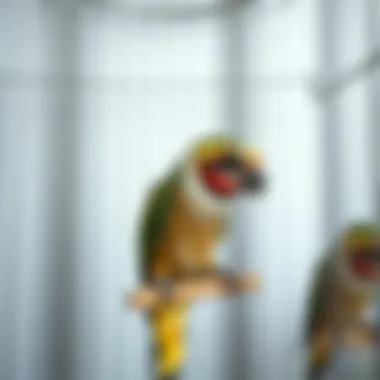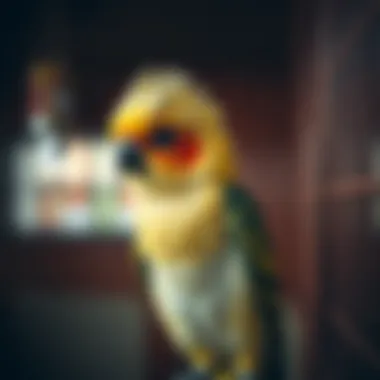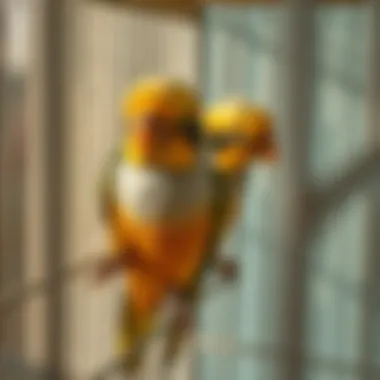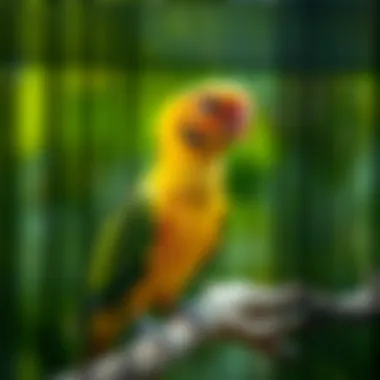Choosing the Best Cage for Indian Ringnecks


Intro
Choosing a cage for your Indian Ringneck parrot is more than just picking out an enclosure; it’s about creating a sanctuary where your feathered friend can thrive. These parrots, known for their inquisitive nature and vibrant personalities, require a habitat that accommodates their unique behaviors and instincts. It’s essential to dive into critical factors, such as size, material, design, and enrichment options available within their environment. By considering these elements, pet owners can not only ensure their pets’ comfort but also enrich their lives significantly.
Understanding Your Pet
To curate the perfect habitat for your Indian Ringneck, it’s imperative to first grasp the essence of their personality and behavior.
Pet Behavior Basics
Ringnecks are social creatures that thrive on interaction. They exhibit playful and curious behavior, often engaging in acrobatics or vocalizing their thoughts. Understanding these traits can help you design a cage that offers space for play and exploration. A cage too small could frustrate their instincts, prompting stress or negative behaviors.
Common Breed Characteristics
These parrots typically range from 16 to 21 inches in length, with the males often displaying a bit more vibrant coloring. While they’re known for their charming vocalizations, Indian Ringnecks also tend to develop strong bonds with their owners. Such characteristics underline the importance of an environment that promotes social interaction and mental stimulation.
Species-Specific Needs
Like any pet, Indian Ringnecks have specific requirements for their habitat. They benefit from a cage that is not only spacious but also well-ventilated. Adding multiple perches at varying heights can provide them with ample opportunity to exercise and engage. Also, consider including a variety of toys to keep their minds sharp and engaged.
Understanding Indian Ringnecks
When it comes to selecting the right cage for your Indian Ringneck parrot, it’s essential to first understand what makes these birds unique. Indian Ringnecks are not just colorful and charming pets; they have distinct characteristics, behaviors, and social needs that play a crucial role in their well-being when housed in captivity. Knowledge about these aspects aids in making an informed decision about their living environment, ultimately affecting their health, happiness, and overall quality of life.
Characteristics of Indian Ringneck Parrots
Indian Ringneck parrots are medium-sized birds known for their striking plumage and delightful vocal abilities. These parrots usually weigh between 90 to 130 grams and have a length of about 16 inches, including their long tails. They come in various colors, with green being the most common, but you can also find blue, yellow, and even white mutations among them. Here are some key characteristics:
- Intelligent: Ringnecks are known for their intelligence, often able to learn a wide range of words and phrases. This trait necessitates mental stimulation, which should be considered in the cage design.
- Curious Nature: Their inquisitive traits mean that they will explore their surroundings fearlessly. A cage offering plenty of opportunities for exploration will cater to their natural instincts and help to keep boredom at bay.
- Social: These birds thrive on social interaction, perhaps more so than many other parrot species. Hence, providing them with a spacious and social-friendly environment is critical for their well-being.
Understanding these characteristics will help to clarify why specific cage features and environments are particularly important.
Behavioral Traits and Social Needs
Behaviorally, Indian Ringnecks are captivating creatures, exhibiting a range of traits that illustrate their dynamic nature. They often require social interaction, and when confined to a cage that lacks social elements, they can become bored or even depressed. Consider the following traits:
- Vocalization: Known for their varied vocal sounds, Indian Ringnecks often vocalize as a form of communication. An enriched environment with various sounds and stimuli can keep them engaged and stimulate their communication skills.
- Exploratory Behavior: These birds might be inclined to chew on and explore their surroundings. To keep them healthy and entertained, the cage must be equipped with safe toys and suitable perches.
- Need for Companionship: They are social birds and do well in pairs or flocks. Having a companion nearby can reduce anxiety and loneliness for your Ringneck; hence, the design of their living space should consider their need for social interaction, whether it’s through human companionship or having another bird.
"A well-informed owner is the key to a healthy and happy Ringneck."
Key Considerations for Cage Selection
When it comes to selecting the right cage for Indian Ringneck parrots, there are several significant factors to weigh. These birds thrive in environments that cater to both their physical and psychological needs. Choosing the premier cage enhances their comfort and quality of life, allowing for a happy and healthy pet. This section delves into the vital elements of cage selection, offering insights that can lead to better decision-making for pet owners.
Ideal Cage Size for Indian Ringnecks
One of the foremost considerations in selecting a cage is size. Indian Ringnecks, with their graceful flights and lively personalities, require space to soar. An inadequte cage can lead to stress, behavioral issues, and even health problems. Ideally, the cage should be large enough to permit the parrot to stretch its wings without restriction. For adult Indian Ringnecks, a cage measuring at least 30 inches in width, 18 inches in depth, and 36 inches in height is recommended.


Adequate space impacts more than just flight; it’s also essential for movement. A spacious cage allows for perches, toys, and other enrichment items that keep the bird engaged. Furthermore, larger cages often include multiple levels, providing opportunities for climbing, which is a natural behavior for these parrots.
"A cage that seems too small can become a prison, inhibiting natural behaviors and causing distress. Size matters in creating a thriving environment for your Ringneck."
Material Considerations: Metal vs. Wood
The material of the cage is another crucial element. Generally, metal and wood are the two prominent options, each with its pros and cons. Metal cages, particularly those made from stainless steel or powder-coated materials, are highly durable and easier to clean. These materials can withstand the gnawing tendencies of parrots, who may chew on bars if they feel bored or anxious.
On the other hand, wooden cages can offer a warmer and more visually appealing environment. However, they often require more maintenance and can be susceptible to damage from bird droppings and moisture over time. It’s essential to choose non-toxic finishes to ensure safety if opting for wooden structures.
Here’s a simplified breakdown of the considerations:
- Metal Cages:
- Wooden Cages:
- Pros: Durable, easy to clean, resistant to chewing
- Cons: Can be less aesthetically pleasing
- Pros: Warm environment, often visually appealing
- Cons: Requires maintenance, more vulnerable to wear and tear
Cage Design Features
Choosing the right cage for an Indian Ringneck parrot isn't just about the materials or size; the design features play a significant role in ensuring your feathered friend thrives. A well-thought-out design can enhance the bird's quality of life, making it crucial for any pet owner to give thoughtful consideration to this aspect. When we talk about cage design features, we refer to elements that directly impact the comfort, safety, and agility of the bird within its living space.
Bar Spacing and Width
The spacing of the bars in the cage is pivotal. It is essential to avoid gaps that are too wide, as this can lead to an escape risk for curious Indian Ringnecks. A cage with well-placed bars must have a spacing of about 1/2 inch to 5/8 inch. This spacing allows your bird to climb and perch securely without the hazard of getting stuck. Additionally, wider bars can pose a danger as they may allow the bird to squeeze through, potentially leading to disastrous outcomes.
A common recommendation is to select cages constructed from sturdy materials that offer both stability and safety. Heavy-duty metals, like stainless steel or powder-coated iron, tend to be the go-to options for bird cages. With appropriate bar width and spacing, an Indian Ringneck can exhibit its natural behaviors, including climbing and flying within the confines of its home.
Cage Shape: Rectangular vs. Square
The shape of the cage is another crucial consideration that influences the areal space available for the bird. Rectangular cages are typically regarded as more beneficial for Indian Ringnecks due to their elongated design. This configuration allows ample horizontal space, catering to the parrot’s instinctive need to fly and exercise.
In contrast, square cages might limit the flight path, although they can provide adequate perching opportunities. To give your bird a more enriching environment, a rectangular cage not only offers more room for movement but can also be designed to include separate spaces for feeding areas and playtime activities.
Ultimately, the decision between a rectangular versus a square cage depends on the available space in your home and the height of the ceilings. For those who don’t mind horizontal space, opting for a rectangular cage is a wise move.
Accessibility and Door Design
It’s not just about the bird’s comfort, but also about how easily a pet owner can access the cage. Consider the cage’s door design carefully. A good cage should have multiple access points, making it easier to refill food and water or perform cleaning duties. The door should be easy to open yet secure enough to avoid any unintended escapes.
Designs with large front doors can make the task of interacting with your pet easier, allowing room for the owner’s hands to enter without too much hassle. Additionally, some cages come with feeding doors that have locking mechanisms or even sliding compartments, adding an extra layer of convenience.
Key Point: Choosing a cage with thoughtful design features such as appropriate bar spacing, shape, and accessible door configurations contributes to the well-being of your Indian Ringneck.
Environment Enrichment in the Cage
Creating a lively and engaging environment for your Indian Ringneck is essential to ensure their happiness and health. The concept of environment enrichment goes beyond merely providing a cage; it involves crafting a space that stimulates physical and mental activity. Parrots are highly intelligent creatures, and they thrive in settings where they can explore, play, and socialize. Without proper enrichment, they may become bored, leading to negative behaviors such as plucking feathers or excessive vocalization. To enhance the well-being of your feathered friend, pay attention to the specific elements that contribute to their cage environment.


Perches and Their Importance
Perches are not just a place for your Indian Ringneck to rest; they play a critical role in their overall health. Having appropriately sized perches can help maintain strong feet and prevent foot-related issues. It’s advisable to provide a variety of perches made from different materials, such as natural wood, as they encourage the birds to exercise their feet while also providing different textures for them to grip. You might consider placing two or more perches at different heights within the cage. This encourages climbing and allows your parrot to engage in natural behaviors.
- Natural Wood Perches: Great for gripping and chewing.
- Sandpaper Perches: Useful for maintaining nail length, but be cautious with overuse.
- Rope Perches: Flexible and comfortable, they can be bent into various shapes.
By changing the arrangement and types of perches regularly, you can keep the environment fresh and intriguing for your bird.
Toys and Interactive Elements
Toys are a quintessential part of environment enrichment for Indian Ringnecks. These interactive elements serve multiple functions, such as providing mental stimulation, promoting physical activity, and reducing boredom. Engaging a parrot with toys that they can chew, shred, or manipulate will not only entertain them but also satisfy their natural instincts.
When selecting toys, keep the following in mind:
- Variety: Include different types of toys like foraging toys, puzzle toys, and swings. This encourages your bird to explore various activities.
- Safety: Ensure that toys are made of bird-safe materials. Non-toxic wood, cotton, and untreated leather are good options.
- Rotation: Frequently rotating toys allows your Indian Ringneck to discover new favorites and ensures they do not get bored with the same items.
Moreover, providing foraging opportunities can keep their minds sharp. Hiding treats in toys or within the cage can mimic the natural search for food, fostering a sense of accomplishment.
Food and Water Placement
The placement of food and water is a basic yet crucial aspect of environment enrichment. Proper allocation can encourage natural behaviors and ensure that your Indian Ringneck has easy access to vital resources. Here are some tips:
- Accessibility: Ensure that food and water bowls are easy for your parrot to reach, but also secured to minimize spills.
- Separation: Place food and water bowls on opposite sides of the cage to encourage movement and exploration. This way, your bird will have to travel, promoting exercise.
- Variety in Diet: Include fresh fruits, vegetables, seeds, and pellets in their diet. A diverse food offering can be placed in foraging toys or scattered around the cage to encourage natural foraging behavior.
By thoughtfully arranging the cage with these elements in mind, you provide a space that nurtures your Indian Ringneck's instincts, curiosity, and overall well-being. The goal is not just to keep the bird alive but to foster a thriving environment that allows your feathered companion to flourish.
"A well-enriched environment is the key to a happy, healthy parrot. It’s not just about survival; it’s about enhancing life quality."
For further reading on bird care and enrichment techniques, visit Wikipedia or Britannica to explore more comprehensive guide on avian care.
Maintenance and Hygiene
Maintaining a clean and hygienic environment for your Indian Ringneck is crucial for several reasons. Not only does proper maintenance ensure the health and vitality of your feathered friend, but it also contributes to the overall quality of life within your home. When these parrots feel comfortable and safe in their cage, they are more likely to exhibit positive behaviors and avoid illnesses. Therefore, a careful approach to cleaning routines and preventing contamination can literally mean the difference between a thriving parrot and one that is less than vibrant.
Regular Cleaning Routines
Establishing a regular cleaning schedule is essential in caring for your Indian Ringneck. Just like you wouldn’t live in a messy room, your parrot deserves a tidy space to call home. Aim for daily cleaning rituals that include:
- Removing uneaten food: Leftover food not only smells bad but also invites pests.
- Changing water: Fresh water should flow daily, as stale water can foster bacteria and diseases.
- Wiping down surfaces: Cage bars, perches, and toys need a clean-off to prevent buildup of waste or food remnants.
Weekly deeper cleaning can also be beneficial, which might include:
- Disinfecting the cage: Gently scrub the cage using a bird-safe cleaner. Ensure all residues are rinsed clean.
- Cleaning toys and perches: Some toys can be soaked in a vinegar and water solution, while others may require thorough scrubbing or replacement.
- Sweeping and mopping: The area around the cage can quickly become littered with feathers and seeds, so keep it spick and span to keep your parrot healthier.
Identifying and Preventing Mold and Bacteria
Mold and bacteria can be lurking in the shadows of an improperly maintained cage. They are sneaky little adversaries to your Ringneck’s health, and recognizing their signs is vital.


Look for:
- Fuzzy growths in corners: This could indicate mold is taking hold. If it’s looking fuzzy, it’s time to clean up.
- Unpleasant odors: If there's an unusual smell around the cage, it may suggest rot or bacterial growth. It’s a wake-up call for cleaning!
- Fecal matter build-up: Not only should you attend to daily cleaning; but excess droppings can become a breeding ground for harmful elements.
Preventing these issues can be achieved with a few mindful practices:
- Ventilation: Make sure your cage is in a well-ventilated area to reduce humidity, which is a friend to mold.
- Material awareness: Opt for cages crafted from materials that resist mold, like stainless steel, rather than those that hold moisture.
- Regular observation: Keep an eye on the conditions of your cage; changes in appearance can tell you about unseen hazards.
Ultimately, by implementing effective cleaning routines and taking steps to combat mold and bacteria, you can significantly enhance your Indian Ringneck’s living conditions. Keeping the cage spotless and free from contaminants is about more than just cleanliness; it is an investment in your pet's health.
"A clean cage is a happy cage. Your parrot's well-being is in your hands."
Outdoor vs. Indoor Caging Options
When it comes to providing the best living environment for your Indian Ringneck, the choice between outdoor and indoor cages is pivotal. Each setup has its own set of advantages and challenges, and understanding these can greatly enhance your bird's quality of life. This section delves into the considerations associated with both outdoor and indoor caging options, aiming to enlighten pet owners about the best practices for their feathered companions.
Advantages of Outdoor Cages
Outdoor cages for Indian Ringnecks can bring a wealth of benefits that align with their natural instincts and thriving requirements. Here are some key points to consider:
- Natural sunlight exposure: Exposure to sunlight is crucial for the health of Ringnecks. It helps synthesize Vitamin D, promoting stronger bones and overall well-being.
- Fresh air and natural sounds: Outdoor settings provide access to fresh air and the symphony of natural sounds which can be stimulating and pleasurable.
- Space for flight: If designed correctly, outdoor cages can be larger, allowing for flight which is essential for their physical and mental health. The more room they have to stretch their wings, the happier and healthier they will be.
- Behavioral enrichment: Being outdoors means engaging with a more vibrant environment, encountering insects and wildlife. This could encourage natural behaviors, keeping them far from boredom.
- Temperature moderation: As long as you keep an eye on extreme weather, outdoor cages can prevent overheating or excessive cold, especially if designed with proper protections.
However, it's important to note that while outdoor cages have many advantages, supervision is crucial. Predators and unpredictable weather can pose significant risks.
Challenges with Indoor Caging
Indoor caging comes with its own set of considerations that every pet owner should recognize. While cozy, indoors can have their drawbacks:
- Limited space for movement: Indoor cages may not always provide the flight space that Ringnecks need. This can lead to mental and physical health issues.
- Artificial lighting: Relying solely on artificial light can lead to Vitamin D deficiencies unless proper solutions like UV lamps are implemented.
- Less stimulation: Environments indoors can sometimes lack the natural sounds and sights that stimulate a bird's senses, making them more susceptible to boredom and its resulting behaviors.
- Traditional hazards: Indoor environments often harbor a host of dangers ranging from toxic plants to open windows and unfenced stairs, hence requiring constant vigilance and adjustments.
- Temperature fluctuations: Indoor climates can vary based on heating and cooling systems. These fluctuations can adversely affect your bird's comfort and health.
It's essential for pet owners to carefully evaluate their living situation and their Ringneck’s needs when deciding between outdoor or indoor caging. A healthy balance along with consistent monitoring is key to providing a suitable habitat.
In summary, both outdoor and indoor options present distinct benefits and challenges. Understanding these nuances equips pet owners to create the best environment for their beloved Indian Ringnecks, securing not just their physical health, but their emotional well-being too.
Final Recommendations
When it comes to selecting the ideal cage for your Indian Ringneck, the final piece of the puzzle involves narrowing down your choices based on several key recommendations. Selecting the right cage is paramount for ensuring a harmonious life for both you and your feathered companion. A carefully curated environment not only enhances their well-being but also contributes to your peace of mind as a pet owner.
Top Cages for Indian Ringnecks
In the realm of cages specifically tailored for Indian Ringnecks, there are a few standout models that deserve mention. These options are not just well-reviewed; they meet the unique needs of these intelligent birds. Here are some noteworthy cages:
- Vision Bird Cages: These cages come with a great design, ensuring that your Ringneck enjoys both space and visibility. Their unique styling also allows for easy access to your pet.
- Zupreem Avian Welfare Cages: Known for their durable build and ample room, they make excellent homes for Ringnecks and offer good airflow, which is essential.
- A&E Cage Company Designs: Offering a variety of shapes and sizes, these cages provide flexible options that cater to both the aesthetics and functional needs of a Ringneck.
Each of these cages boasts features such as adequate bar spacing, easy cleaning mechanisms, and sufficient perching areas that can aid in keeping your pet active and happy. Additionally, checking for bird-safe materials is vital in your selection process.
Budget Considerations
While splurging on a high-quality cage might seem appealing, it's crucial to establish a budget that aligns with your financial comfort. Cages can vary significantly in price, and with that, the features also differ. Consider the long-term investment you are making in your pet’s health and happiness. It often pays to think ahead.
- Entry-Level Cages: Starting around $75, these cages can be adequate for young Ringnecks or those that don’t require expansive space upfront. They may not include the bells and whistles but can be great for a starter setup.
- Mid-Range Options: With prices generally between $150 and $300, you can find a robust cage with essential features designed specifically for Indian Ringnecks. This price point often includes better materials and larger sizes, which can be more beneficial for your bird’s long-term health.
- Premium Cages: Spanning from $400 and up, these cages emphasize durability, spaciousness, and specialized design features. Investing in these can afford your pet a much more enriched environment for play and relaxation.
Ultimately, thorough research will ensure you find a cage that satisfies both your budget constraints and your Indian Ringneck's lifestyle needs. By balancing quality with cost, you prepare for the best possible shell for your bird's everyday adventures.







